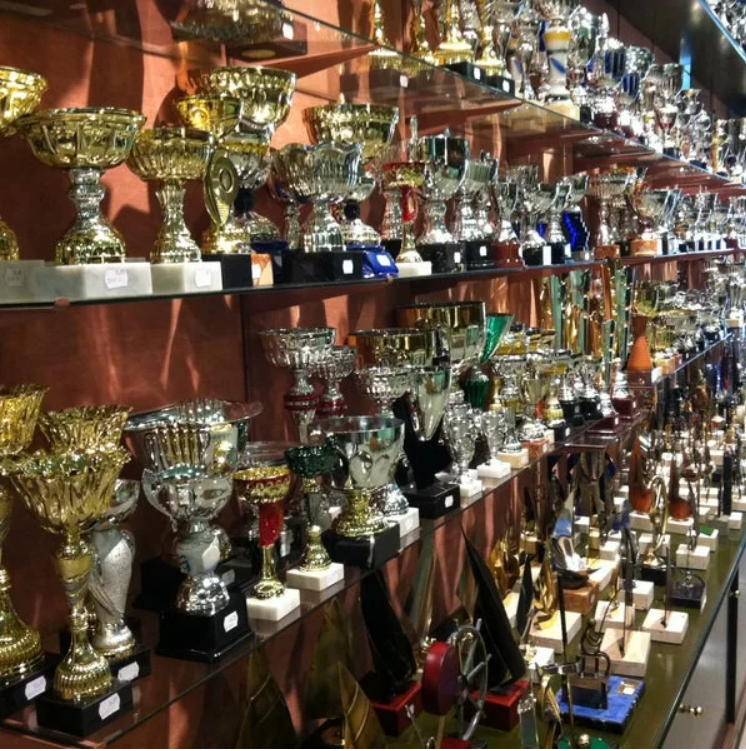
Where does the custom of handing out a trophy when you get an achievement come from?
Awards and accolades have been used to acknowledge notable victories since ancient times. The word trophy is derived from the French trophée in 1513, meaning “a booty or spoils of war,” and the Latin Trophaeum meaning “monument to victory.”
Prizes can take the form of two-handled cups, bowls, mugs, or statues of people, animals, and architecture while displaying words, numbers, or pictures. Many styles are available, and it is entirely up to the client which style and design they prefer for their ceremony.
Ancient Greece
In ancient Greece, the awards themselves were made on the battlefields using captured weapons and banners and were hung on a tree or whatever was handy to form the figure of a warrior. These were often inscribed in a story of the battle and were commonly dedicated to different gods. Reconnaissance conducted by naval victories often consisted of entire ships (or what was left of them) left on the beach for all to see. Destroying one of these ships or structures made in combat on a battlefield was considered sacrilege and an unforgivable crime.
It has been said that a common award in ancient Greece was the laurel wreath, which was awarded during the Olympic Games. It was also said that when the warriors went into battle and had a great victory overcoming other clans, they created a prize made from the decomposing bodies of the enemies on the battlefield as a tribute to the gods.
Captured weapons and severed heads were structured in a way that looked like a warrior in a fighting stance and celebrated around this construction.
Ancient Rome
The Romans, however, kept their accolades closer to home. They built magnificent trophies in Rome, like columns and arches on top of the great foundations. Unfortunately, most of the stone awards that once adorned great stone monuments in Rome have long since been stolen.
In ancient Rome, trophies came in the form of money or coins, but it was also said that when Roman warriors won a battle, various columns were built on top of mountains in cities as a symbol of their triumph.
The Middle Ages
As for the Middle Ages, the chalices (Cups and glasses) were frequently given to the winners of sporting events, at least, that is the data that we have according to many investigations that place us in the late 1600s.
It was in the 1600s in the New World that the cup structure was generally two-handled and made of money. This type of award is build on the success of sporting events of the time, such as horse racing, regattas and soon races.
Today
Trophies are still the prizes that winners receive when they are better than others in some competition, in spirit and skills. It is the manifestation of victory and are considered keepsakes and memories of success.
The Glass Awards
Glass is another material used in making these awards. This hard and transparent material is made with a mixture of silica oxide (sand) as a vitrifying agent, sodium oxide (soda) as a flux and calcium oxide (lime) as a stabilizer, these are the most important, in addition to these others enter oxides in less quantity that will be the refiners, dyes and bleaches. After submitting the mixture inside a furnace at temperatures between 1300 and 1800 degrees, a mixture appears in a semi-liquid state that, after a cooling process, either tempering or annealing, gives the glass as the final product.
The glass used in the manufacture of a recognition is a much stronger glass than what we commonly use in other items, so it does not break as easily as normal glass.
This is the main reason why a glass trophy is more expensive than acrylic. Engraving glass is not that easy, so award makers use sophisticated technology tools to make these designs and engravings on glass awards.
The Crystal Awards
The last material commonly used in trophy making is also the most expensive, glass. This material bears an uncanny resemblance to diamonds. However, it is not as hard as diamond.
The only drawback of a crystal trophy is its cost relative to other materials such as glass, acrylic and commonly used metals such as brass, if we compare crystal to other materials such as acrylic glass, the cost of the Making an award with this material will be more expensive than the others.
Glass is a hard material that is capable of surviving for long periods of time.
One of the main advantages of crystal trophies is that you can engrave personal messages or the names of the award recipients on them. In addition, there are different customizations such as engraving a personalized image, dedication or special feature that can be requested on request.
In this type of recognition there are no limits to the designs, engravings and customization issues that can be made, we put at your disposal our system so that your imagination has no limits when creating the trophy you want.


